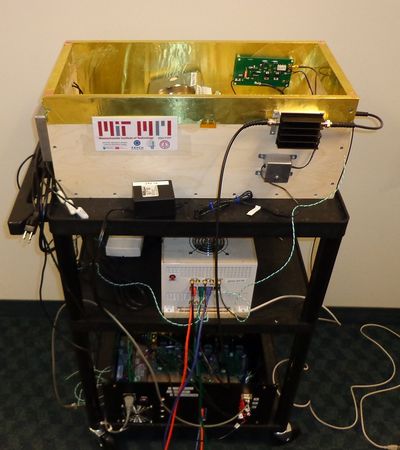Difference between revisions of "Main Page"
| Line 1: | Line 1: | ||
This Wiki is a resource for people who are assembling, programming, or using the instructional tabletop MRI scanner developed by [http://www.nmr.mgh.harvard.edu/martinos/people/showPerson.php?people_id=178 Larry Wald's group] at the [http://www.nmr.mgh.harvard.edu/martinos/flashHome.php Martinos Center for Biomedical Imaging], [http://www.massgeneral.org/ Massachusetts General Hospital]. | This Wiki is a resource for people who are assembling, programming, or using the instructional tabletop MRI scanner developed by [http://www.nmr.mgh.harvard.edu/martinos/people/showPerson.php?people_id=178 Larry Wald's group] at the [http://www.nmr.mgh.harvard.edu/martinos/flashHome.php Martinos Center for Biomedical Imaging], [http://www.massgeneral.org/ Massachusetts General Hospital]. | ||
| − | The scanner design is | + | The scanner design is a low-cost resource for demonstrating the concepts like magnetic resonance, spatial encoding, and the Fourier transform in an educational setting. The system was first used in MIT's undergraduate course [http://www.eecs.mit.edu/academics-admissions/academic-information/subject-updates-st-2013/6s02 6.S02 - Intro to EECS II from a Medical Technology Perspective]. Most of the components are open source designs. |
The design was made possible through a collaboration between MGH, the Chinese Academy of Sciences (who built the magnets), Pascal Stang of Stanford University (who provided the MEDUSA console), and Maxim Zaitsev's group at the University of Freiburg (who designed the gradient coil traces). During fabrication we also benefited from access to the equipment and resources of the [http://cba.mit.edu/ Center for Pits and Atoms] at the [http://media.mit.edu/ MIT Media Lab]. | The design was made possible through a collaboration between MGH, the Chinese Academy of Sciences (who built the magnets), Pascal Stang of Stanford University (who provided the MEDUSA console), and Maxim Zaitsev's group at the University of Freiburg (who designed the gradient coil traces). During fabrication we also benefited from access to the equipment and resources of the [http://cba.mit.edu/ Center for Pits and Atoms] at the [http://media.mit.edu/ MIT Media Lab]. | ||
Revision as of 21:21, 11 November 2013
This Wiki is a resource for people who are assembling, programming, or using the instructional tabletop MRI scanner developed by Larry Wald's group at the Martinos Center for Biomedical Imaging, Massachusetts General Hospital.
The scanner design is a low-cost resource for demonstrating the concepts like magnetic resonance, spatial encoding, and the Fourier transform in an educational setting. The system was first used in MIT's undergraduate course 6.S02 - Intro to EECS II from a Medical Technology Perspective. Most of the components are open source designs.
The design was made possible through a collaboration between MGH, the Chinese Academy of Sciences (who built the magnets), Pascal Stang of Stanford University (who provided the MEDUSA console), and Maxim Zaitsev's group at the University of Freiburg (who designed the gradient coil traces). During fabrication we also benefited from access to the equipment and resources of the Center for Pits and Atoms at the MIT Media Lab.
First delivery to MIT: photo here Systems ready to roll out: photo here
Introduction
Other low-cost tabletop imaging systems:
Desktop MRI system with 2 cm bore from Steve Wright's lab at Texas A&M.
Open Source Mobile MR Relaxometer from Mark Griswold's lab at Case Western.
Terranova-MRI earth's field system from Magritek.
MRIjx table top teaching system from Niumag in Shanghai.
Pure Devices 0.5T tabletop system from Würzburg, Germany.
Hardware
Sequences
Images
Lab Manuals + Course Notes
References
Consult the User's Guide for information on using the wiki software.
